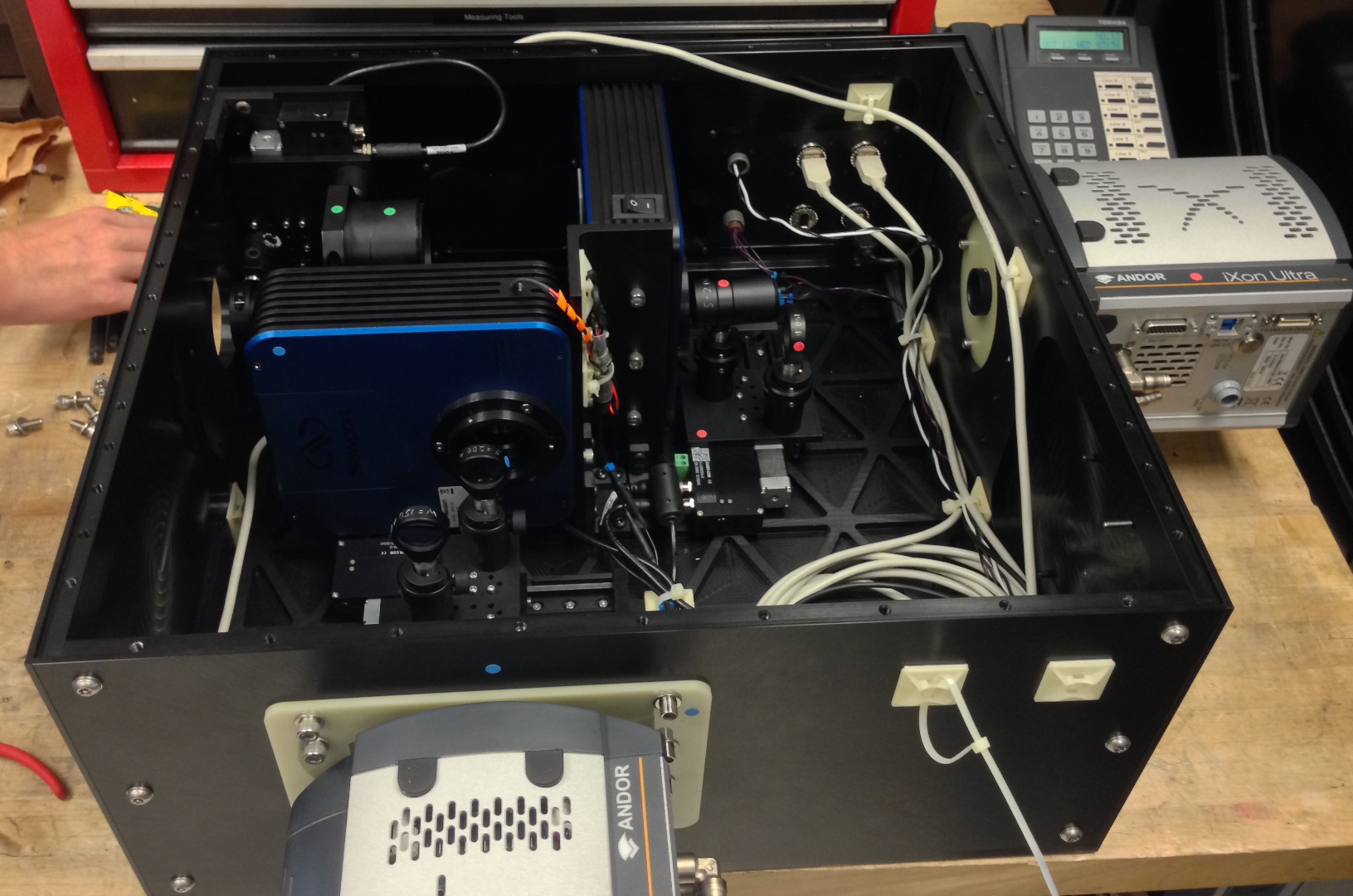

NESSI was commissioned starting in Oct. 2016 after being built and designed by Nic Scott and Steve Howell (NASA/Ames) and Elliott Horch (Southern Connecticut State University) with funding from the NASA-NSF Exoplanet Observational Research partnership, NN-EXPLORE.
A description of NESSI is published by Scott et al. 2018
NESSI is an optical imaging system capable of speckle interferometry, high-speed photometry, and imaging with sampling at small plate scales. It is optimized for optical speckle imaging of point sources. It employs two Andor iXon Ultra 888 electron multiplying CCDs (EMCCDs), which operate simultaneously in blue and red channels and have detectors with 1024x1024 active pixels.
In NESSI, the telescope beam is collimated and then split, using a dichroic, into blue and red channels at 686nm. Each channel is passed through a filter wheel which currently contains a selection of SDSS ugriz filters and narrower-band speckle filters having central wavelengths of 467, 562, 716 and 832 nanometers. NESSI can image at two different fields-of-view and plate scales by switching on the fly between two sets of optics. NESSI's 'wide' field mode has an approximately 83x83 arcseconds FOV with a 0.08 arcsec/pixel plate scale and its narrower 'speckle' FOV is 19x19 arcseconds with 0.018 arcsec/pixel. Both cameras must operate together in either the wide or narrow field mode.
The Andor cameras can operate at high speeds with shutterless exposures by using a frame-transfer mode, wherein charge is quickly shifted from the exposed "active area" pixels vertically into an identical 1024x1024 array of shielded pixels from which readout commences. While fast readout produces high readnoise, this is overcome by passing the collected charge through an electron multiplying register, which amplifies the electrons to produce an effectively much lower readnoise. The cameras can also be operated as conventional CCDs or without the frame transfer function and with an optional mechanical shutter (although the frame transfer mode may be preferred in general). Using NESSI in its conventional imaging mode is preferable for projects with longer exposure times (longer than ~1 second). This is because the conventional mode CCD readouts offer a more stable bias pattern that can be more easily calibrated and allow low readnoise readout of the detectors (with unbinned, full frame readout possible in about 1 second). Note that not all of the full functionality of the Andor cameras is possible within the NESSI instrument control software and prospective NESSI users should consult with the instrument scientist if they envision using NESSI in some of the lesser-used modes.
Proposals to use NESSI are solicited through the NN-EXPLORE program proposal process at NOIRLab (NN-EXPLORE is a program aimed at enabling exoplanet science). WIYN university partners may also submit proposals to use NESSI.
Almost all NESSI observations are carried out as part of a multi-program observation queue that operates a few times per year when NESSI is installed at WIYN. The queue is operated by WIYN personnel. Observers who use the NESSI queue for speckle imaging submit target lists and basic instructions about target priority and exposure times and then receive back high-level reduced data products after the queue observing runs. The speckle data reduction is done using a pipeline at NOIRLab run by the instrument scientist and the resulting data are generally made available for PIs to download within a few weeks following queue observing runs. Other types of observations may be submitted to the queue, but data reduction is left in the hands of the PI.
Proposers or users of the NESSI speckle imaging queue should read the pages describing speckle imaging using NESSI.
For inquiries about NESSI contact the support scientist, Mark Everett (mark.everett@noirlab.edu).
A request for acknowledgement is made of authors using NESSI data in publications.
NESSI data products produced by certain exoplanet science programs are being archived by IPAC at the ExoFOP archive through the support of PI's who wish to promote collaborative use of their data by the exoplanet community. There is no online archive of NESSI data hosted by NOIRLab. One reason is that the rather excessive amount of raw data collected (>100GB on many nights) is cumbersome and few astronomers want to access that. Raw data can be provided to users who want it (contact the instrument scientist).
See WIYN's NESSI webpage for more overview of the instrument.